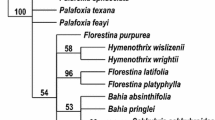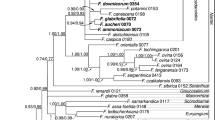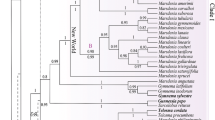Abstract
Using DNA sequence data from nuclear ribosomal ITS in combination with plastid trnLF spacer and trnL intron data, we show that Sibbaldia is a polyphyletic assemblage. It falls into five separate clades of Potentilleae, three within Fragariinae and two within Potentilla (Potentillinae sensu Soják). To a large extent, our results are congruent with Soják’s findings based on morphological characters such as anther structure. Four of the Sibbaldia species included in this study remain in Sibbaldia, while S. adpressa is classified in Sibbaldianthe, S. perpusilloides is considered to represent a new genus in Fragariinae, Chamaecallis Smedmark, S. micropetala is nested within the Potentilla anserina clade, and four species belong to a basal clade of Potentilla. The phylogenetic affinity of Sibbaldiopsis is still unsettled, but one of the three species that have been classified in the genus is found to belong inside Sibbaldia, and it should be named Sibbaldia retusa (O.F. Müller) T. Erikss. Further study will show whether the remaining two species, Potentilla cuneifolia and P. miyabei, are more closely related to Sibbaldia, Sibbaldianthe, or if they make up a distinct lineage separate from either of these.

Similar content being viewed by others
References
Baum DA, Sytsma KJ, Hoch PC (1994) A phylogenetic analysis of Epilobium (Onagraceae) based on nuclear ribosomal DNA sequences. Syst Bot 19:363–388
Bentham G (1858) Handbook of the British flora. L Reeve Co, London
Böcher TW, Holmen K, Jakobsen K (1966) Grønlands flora, 2nd edn. Haase sons, København
Bunge AA (1829) Pentgynia. In: Ledebour CF (ed) Flora altaica, vol 1. G Reimer, Berlin, pp 428–433
Chatterjee D (1938) A note on the Indian and Chinese species of the genus Sibbaldia. Linn Notes RBG Edinb 19:325–327
Dalgaard V (1989) Additional chromosome numbers in vascular plants from the Disko Bugt area (west Greenland). Willd 19:199–213
Dikshit BK, Panigrahi G (1998) The family Rosaceae in India (revisionary studies on Potentilla L., Sibbaldia L., Brachycaulos Dikshit, Panigr.). Bishen Singh Mahendra Pal Singh, Dehra Dun
Dixit BK, Panigrahi G (1981) Revision of the genus Sibbaldia L. (Rosaceae). India Proc Indian Acad Sci (Plant Sci) 90:253–272
Dobeš C, Paule J (2010) A comprehensive chloroplast DNA-based phylogeny of the genus Potentilla (Rosaceae): implications for its geographic origin, phylogeography and generic circumscription. Mol Phylogenet Evol 56:156–175
Doyle JJ, Doyle JL (1990) Isolation of plant DNA from fresh tissue. Focus 12:13–15
Endlicher S (1840) Genera plantarum, vol 2. Fr Beck, Wien
Eriksson T, Donoghue MJ, Hibbs MS (1998) Phylogenetic analysis of Potentilla using DNA sequences of nuclear ribosomal internal transcribed spacers (ITS), and implications for the classification of Rosoideae (Rosaceae). Pl Syst Evol 211:155–179
Eriksson T, Hibbs MS, Yoder AD, Delwiche CF, Donoghue MJ (2003) The phylogeny of Rosoideae (Rosaceae) based on sequences of the internal transcribed spacers (ITS) of nuclear ribosomal DNA and the trnL/F region of chloroplast DNA. Int J Pl Sci 164:197–211
Farr ER, Leussink JA, Stafleu FA (1979) Index nominum genericorum (Plantarum), vol 3. Regnum vegetabile 102. Bohn, Scheltema and Halkema, Utrecht
Focke WO (1888) Potentilleae. In: Engler A, Prantl K (eds) Die naturlichen Pflanzenfamilien III(3). Engelmann, Leipzig, pp 32–36
Gehrke B, Bräuchler C, Romoleroux K, Lundberg M, Heubl G, Eriksson T (2008) Molecular phylogenetics of Alchemilla, Aphanes and Lachemilla (Rosaceae) inferred from plastid and nuclear intron and spacer DNA sequences, with comments on generic classification. Mol Phylogenet Evol 47:1030–1044
Guindon S, Gascuel O (2003) A simple, fast, and accurate algorithm to estimate large phylogenies by maximum likelihood. Syst Biol 52:696–704
Handel-Mazzetti H (1939) Plantae Sinensis. Rosaceae. 1: Potentillineae. Acta Horti Gothob 13:289–334
Helfgott DM, Francisco-Ortega J, Santos-Guerra A, Jansen RK, Simpson BB (2000) Biogeography and breeding system evolution of the woody Bencomia alliance (Rosaceae) in Macaronesia based on ITS sequence data. Syst Bot 25:82–97
Hill J (1756) The British herbal: an history of plants and trees, natives of Britain cultivated for use or raised for beauty. T. Osborne, London
Holmgren PK, Holmgren NH, Barnett LC (eds) (1990) Index herbariorum, part I: the herbaria of the world, 8th edn. IAPT and New York Botanical garden, New York
Hooker JD (1865) Rosaceae. In: Bentham G, Hooker JD (eds) Genera plantarum, vol 1. Reeve and co., London, pp 600–629
Hooker JD (1878) Rosaceae (Potentilla). The flora of British India, vol II. L. Reeve Co., London, pp 345–360
Huelsenbeck JP, Ronquist FR (2001) MRBAYES: Bayesian inference of phylogeny. Bioinformatics 17:754–755
Hurvich CM, Tsai C-L (1989) Regression and time series model selection in small samples. Biometrika 76:297–307
Hutchinson J (1964) The genera of flowering plants, vol 1, dicotyledons. Clarendon Press, Oxford
Ikeda H (1989) Chromosome numbers of Himalayan Potentilla (Rosaceae). J Jap Bot 64:361–367
Ikeda H, Ohba H (1999) A systematic revision of Potentilla L. section Leptostylae (Rosaceae) in the Himalaya and adjacent regions. Bull Univ Mus Univ Tokyo 39:31–117
Ikeda H, Ohba H, Subedi MN (2004) Sibbaldia minutissima Kitam. (Rosaceae) is conspecific to S. adpressa. Studies of the Flora of Mustang, Central Nepal, 2. J Jap Bot 79:91–95
Juzepchuk SV (1941) Rosoideae. In: Flora of the USSR, vol X. Izdatelstvo Akademii Nauk SSSR, Moskva-Leningrad, pp 3–380
Keck DD (1938) Revision of Horkelia and Ivesia. Lloydia 1:75–142
Kurtto A, Eriksson T (2003) Atlas Florae Europaeae notes. 15. Generic delimitation and nomenclatural adjustments in Potentilleae (Rosaceae). Ann Bot Fenn 40:135–141
Li C, Ikeda H, Ohba H (2003) Sibbaldia. Flora of China. 9. Science Press, Beijing, pp 329–333
Linnaeus C (1753) Species plantarum 1. Salvius, Stockholm
Linnaeus C (1754) Genera plantarum. Salvius, Stockholm
Löytynoja A, Goldman N (2005) An algorithm for progressive multiple alignment of sequences with insertions. Proc Natl Acad Sci USA 102:10557–10562
Löytynoja A, Goldman N (2008) Phylogeny-aware gap placement prevents errors in sequence alignment and evolutionary analysis. Science 320:1632–1635
Lundberg M, Töpel M, Eriksen B, Nylander JAA, Eriksson T (2009) Allopolyploidy in Fragariinae (Rosaceae): comparing four DNA sequence regions, with comments on classification. Mol Phylogenet Evol 51:269–280
Muravjova OA (1936) The genus Sibbaldia L. and its species. Acta Inst Bot Acad Scient URSS Sér 1 Fasc 2:217–241
Nestler CG (1816) Monographia de Potentilla. Treuttel, Würtz, Paris
Nylander JAA (2004) MrAIC.pl. https://github.com/nylander/MrAIC
Nylander JAA, Wilgenbusch JC, Warren DL, Swofford DL (2008) AWTY (are we there yet?): a system for graphical exploration of MCMC convergence in Bayesian phylogenetics. Bioinformatics 24:581–583
Paule J, Soják J (2009) Taxonomic comments on the genus Sibbaldiopsis Rydb. (Rosaceae). J Natl Mus (Prague), Nat Hist Ser 178:15–16
Potter D, Eriksson T, Evans RC, Oh S, Smedmark JEE, Morgan DR, Kerr M, Robertso KR, Arsenault M, Dickinson TA, Campbell CS (2007) Phylogeny and classification of Rosaceae. Pl Syst Evol 266:5–43
Rajput MTM, Tahir SS (2008) A new species of the genus Sibbaldia (Rosaceae) from south east Asia. Pak J Bot 40:2255–2258
Rajput MTM, Tahi SS, Hussain SZ, Spongberg SA (1997) The genus Sibbaldia (Rosaceae). Pak J Bot 29:1–38
Rambaut A (2002) Se-Al. Computer software distributed by the author. Institute of Evolutionary Biology, University of Edinburgh. Version 2.0. http://tree.bio.ed.ac.uk/software/seal/
Robertson K (1974) The genera of Rosaceae in the Southeastern United States. J Arnold Arbor 55:303–401
Ronquist F, Huelsenbeck JP (2003) MRBAYES 3: bayesian phylogenetic inference under mixed models. Bioinformatics 19:1572–1574
Rydberg PA (1898) A monograph of the North American Potentilleae. In: Memoirs from the Department of Botany of Columbia University, Columbia University, New York, pp 1–223
Rydberg PA (1908) Rosaceae. In: North American flora, vol 22. The New York Botanical Garden, New York
Seringe NC (1825) Potentilla. In: De Candolle AP (ed) Prodromus systematis naturalis regni vegetabilis. Treuttel, Würtz, Paris, pp 571–586
Smith JE (1811) Lachesis Lapponica or a tour in Lapland by Linnaeus, vol I. Taylor Co, London
Soják J (1970) Taxonomische und phytogeographische Anmerkungen zur Gattung Potentilla. Preslia 42:70–81
Soják J (1988) Notes on Potentilla (Rosaceae) VII. Some Himalayan taxa. Candollea 43:437–453
Soják J (1989) Generická problematika Potentilla s.l. Cas Nár Muz Rada Prir 154:117–118
Soják J (2004) Potentilla L. (Rosaceae) and related genera in the former USSR (identification key, checklist and figures). Notes on Potentilla XVI. Bot Jahrb Syst 125:253–340
Soják J (2007) Potentilla (Rosaceae) in China. Notes on Potentilla XIX. Harv Pap Bot 12:285–324
Soják J (2008) Notes on Potentilla XXI. A new division of the tribe Potentilleae (Rosaceae) and notes on generic delimitations. Bot Jahrb Syst 127:349–358
Soják J (2010) Argentina Hill, a genus distinct from Potentilla (Rosaceae). Thaiszia: J Bot 20:91–97
Spenner FCL (1829) Flora friburgensis. Brisgoviae, Friburg, p 1084
Staden R (1996) The Staden sequence analysis package. Mol Biotechnol 5:233–241
Sugiura N (1978) Further analysis of data by Akaike’s information criterion and finite corrections. Comm St A 7:13–26
Taberlet P, Gielly L, Pautou G, Bouvet J (1991) Universal primers for amplification of three non-coding regions of chloroplast DNA. Pl Mol Biol 17:1105–1109
Tavaré S (1986) Some probabilistic and statistical problems in the analysis of DNA sequences. Lect Math Life Sci 17:57–86
Töpel M, Lundberg M, Eriksson T, Eriksen B (2011) Molecular data and ploidal levels indicate several putative allopolyploidization events in the genus Potentilla (Rosaceae). PloS Curr. doi:10.1371/currents.RRN1237
Urbatsch LE, Baldwin B, Donoghue MJ (2000) Phylogeny of coneflowers and relatives (Heliantheae: Asteraceae) based on nuclear rDNA internal transcribed spacer (ITS) sequences and chloroplast DNA restriction site data. Syst Bot 25:539–565
White TJ, Bruns T, Lee S, Taylor J (1990) Amplification and direct sequencing of fungal ribosomal RNA genes for phylogenetics. In: Innis MA, Gelfand DH, Sninsky JJ, White TJ (eds) PCR protocols: a guide to methods and applications. Academic Press, London, pp 315–322
Wolf T (1908) Monographie der Gattung Potentilla. Biblioth Bot 16(Heft 71):1–714
Yang Z (1993) Maximum-likelihood estimation of phylogeny from DNA sequences when substitution rates differ over sites. Molec Biol Evol 10:1396–1401
Yang Z, Rannala B (1997) Bayesian phylogenetic inference using DNA sequences: a Markov chain monte carlo method. Molec Biol Evol 14:717–724
Yü T-T, Li C-L (1981) New species of Sibbaldia from China. Acta Phytotax Sin 19:515–518
Acknowledgments
We are grateful for the access to herbarium material from the herbaria in Stockholm (S), Copenhagen (C) and London (BM, K). We are also grateful for being able to cultivate certain species in the Bergius Botanic Garden, Stockholm. We thank A. Yoder (Duke University) and E. Conti (Universität Zürich) for help with sequencing during lean times and B. Ertter (University of California, Berkeley) for information on Horkelia.
Author information
Authors and Affiliations
Corresponding author
Rights and permissions
About this article
Cite this article
Eriksson, T., Lundberg, M., Töpel, M. et al. Sibbaldia: a molecular phylogenetic study of a remarkably polyphyletic genus in Rosaceae. Plant Syst Evol 301, 171–184 (2015). https://doi.org/10.1007/s00606-014-1063-3
Received:
Accepted:
Published:
Issue Date:
DOI: https://doi.org/10.1007/s00606-014-1063-3




